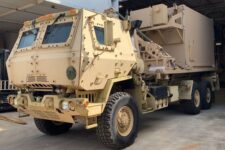 The House of Representatives will vote on the 2014 National Defense Authorization Act later this week. Sequestration will be the giant hiding behind the door as the House Armed Services Committee has marked its bill to the Obama budget request, which means that the effects of sequestration are ignored by the bill (as they are ignored by the administration’s budget.) Into this vacuum steps the chairman of the National Defense Industrial Association, who heads EADS NA, the North American subsidiary of the European defense giant. See what Sean O’Keefe believes must be done. The Editor.
The House of Representatives will vote on the 2014 National Defense Authorization Act later this week. Sequestration will be the giant hiding behind the door as the House Armed Services Committee has marked its bill to the Obama budget request, which means that the effects of sequestration are ignored by the bill (as they are ignored by the administration’s budget.) Into this vacuum steps the chairman of the National Defense Industrial Association, who heads EADS NA, the North American subsidiary of the European defense giant. See what Sean O’Keefe believes must be done. The Editor.
By Sean O’Keefe
Forrest Gump was right. “Stupid is as stupid does.” It is coming as no surprise that “sequestration,” the dumbest fiscal management policy ever conceived, is already producing some pretty mindless results.
As bad as the damage is from enduring automatic salami-slicing of budget line items, perhaps what is worse is the evisceration of already low public confidence in both legislative and executive branch leadership, coupled with the complete demoralization of the career public service facing furloughs on a regular basis for the next several months.
Sequestration was created by frustrated budget negotiators who felt that the pain it might portend would be so great that surely wiser heads would prevail and a budget deal would be achieved. Clearly, the negotiators underestimated our government’s capacity for sustaining self-inflicted wounds. It is as if the now-recognized “Mayhem” guy of Allstate commercial fame has found a new job.
The reports are just beginning to come in, but you don’t have to look hard to find plenty of near-term decisions that will make savings at the margin only to create larger bills in the future. Public leaders don’t try to make nonsensical decisions — but there is something about the current budgetary environment that makes such actions more likely. It is as if we have rendered null and void Winston Churchill’s observation, “Gentlemen, we have run out of money, now we have to think.”
Whether talking about how a government which pays for studies of duck genitalia and cuts funding that allows school kids to tour the White House, cancels deployment of an aircraft carrier to the Middle East at a time of heightened tensions with Iran, the federal government abounds with examples of head-scratching decisions. As chairman of the National Defense Industrial Association, an organization of nearly 2,000 corporations, big and small, dedicated to the defense of this country and our allies, a day doesn’t go by where I don’t hear of another example of bad ideas adopted in the name of efficiency.
The uncertainty hits particularly hard on some of the smallest but critical parts of our industrial base. Chief of Naval Operations Admiral Jonathan Greenert said at a recent congressional hearing, that 90 percent of the Navy’s nuclear components come from smaller companies that are a sole supplier. “If it’s not the prime [contractor] it’s below the prime, it’s the second or third. It’s Bob’s nuclear valve shop, Jimmy’s nuclear.”
And yet an over-reliance on single sources of critical supplies seems to be a growing trend. A recent GAO report found that DoD is increasingly forgoing contract competition in its purchases. According to the report, only 37.1 percent of Air Force contracts were competed. There are some instances where sole-source contracts may make sense or are the only unique supplier – but 63 percent of the time?
The Defense Department unveiled its “Better Buying Power 2.0” policy just a few months ago to promote effective competition, eliminate wasted time on process steps, and control costs. The time to press hard for these reforms is now. Although no sane person should welcome the constraints imposed by sequestration, government officials can make chicken salad out of what they’ve been given and find ways to revamp the procurement system, suspend autopilot application of reams of regulations, and take advantage of competition and innovation.
Numerous studies have documented that products sold to the Defense Department cost 15-20 percent more than they do when sold to commercial customers. The overhead of doing business with the government accounts for much of that cost differential. Instead of trying to figure out how to buy more for less, maintaining the status quo is a surefire way to get less for more.
The uncertainty of the budget situation makes the jobs of acquisition officials particularly difficult. Heidi Shyu, the Army’s acquisition chief, said not long ago, “I don’t know what my budgets are going to be. I’m standing on quicksand right now.” That has the unintended consequence of prompting industry to withhold investments that would otherwise improve performance or effectiveness. And that, in turn has the effect of compromising the very goals of the Better Buying Power initiative.
Reform advocates need to think several moves ahead. Some of the “savings” achieved by cuts in the immediate future will just drive up procurement costs just down the road. As difficult as the current budget environment is, the crisis does present opportunities for leaders to seize the opportunity to make structural and regulatory changes that in a normal time would be impossible to achieve. Adopting the recommendations of the Defense Business Board report on process reforms would be a great start.
Sean O’Keefe is chairman of the National Defense Industrial Association and is CEO and chairman of the board of EADS North America.
—
No service can fight on its own: JADC2 demands move from self-sufficiency to interdependency
Making all-domain operations a warfighting capability means integrating, fusing, and disseminating a sensor picture appropriate for a particular theater segment, not all of them, says the Mitchell Institute’s David Deptula.



























